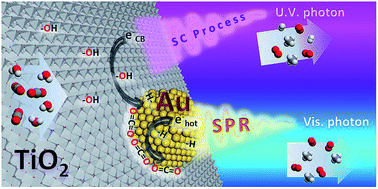当前位置:
X-MOL 学术
›
Faraday Discuss.
›
论文详情
Our official English website, www.x-mol.net, welcomes your
feedback! (Note: you will need to create a separate account there.)
Plasmonic photocatalysis applied to solar fuels
Faraday Discussions ( IF 3.3 ) Pub Date : 2018-11-16 , DOI: 10.1039/c8fd00144h Steven Bardey 1, 2, 3, 4, 5 , Audrey Bonduelle-Skrzypczak 4, 5, 6 , Antoine Fécant 4, 5, 6 , Zhenpeng Cui 7, 8, 9, 10, 11 , Christophe Colbeau-Justin 7, 8, 9, 10, 11 , Valérie Caps 1, 2, 3, 4 , Valérie Keller 1, 2, 3, 4
Faraday Discussions ( IF 3.3 ) Pub Date : 2018-11-16 , DOI: 10.1039/c8fd00144h Steven Bardey 1, 2, 3, 4, 5 , Audrey Bonduelle-Skrzypczak 4, 5, 6 , Antoine Fécant 4, 5, 6 , Zhenpeng Cui 7, 8, 9, 10, 11 , Christophe Colbeau-Justin 7, 8, 9, 10, 11 , Valérie Caps 1, 2, 3, 4 , Valérie Keller 1, 2, 3, 4
Affiliation

|
The induction of chemical processes by plasmonic systems is a rapidly growing field with potentially many strategic applications. One of them is the transformation of solar energy into chemical fuel by the association of plasmonic metal nanoparticles (M NPs) and a semi-conductor (SC). When the localized surface plasmon resonance (LSPR) and the SC absorption do not match, one limitation of these systems is the efficiency of hot electron transfer from M NPs to SC through the Schottky barrier formed at the M NP/SC interfaces. Here we show that high surface area 1 wt% Au/TiO2-UV100, prepared by adsorption of a NaBH4-protected 3 nm gold sol, readily catalyzes the photoreduction of carbon dioxide with water into methane under both solar and visible-only irradiation with a CH4vs. H2 selectivity of 63%. Tuning Au NP size and titania surface area, in particular via thermal treatments, highlights the key role of the metal dispersion and of the accessible Au–TiO2 perimeter interface on the direct SC-based solar process. The impact of Au NP density in turn provides evidence for the dual role of gold as co-catalyst and recombination sites for charge carriers. It is shown that the plasmon-induced process contributes up to 20% of the solar activity. The plasmon-based contribution is enhanced by a large Au NP size and a high degree of crystallinity of the SC support. By minimizing surface hydroxylation while retaining a relatively high surface area of 120 m2 g−1, pre-calcining TiO2-UV100 at 450 °C leads to an optimum monometallic system in terms of activity and selectivity under both solar and visible irradiation. A state-of-the-art methane selectivity of 100% is achieved in the hot electron process.
中文翻译:

等离子体光催化应用于太阳能
等离子体系统诱导化学过程是一个快速发展的领域,具有许多潜在的战略应用。其中之一是通过等离子体金属纳米颗粒(M NPs)和半导体(SC)的结合将太阳能转化为化学燃料。当局部表面等离振子共振(LSPR)和SC吸收不匹配时,这些系统的局限性是热电子从M NPs通过在M NP / SC界面处形成的肖特基势垒转移到SC的效率。在这里我们表明,通过吸附NaBH 4保护的3 nm金溶胶制备的高表面积1 wt%Au / TiO 2-UV100,在阳光和仅可见光照射下,很容易催化水与二氧化碳之间的光还原反应生成甲烷。带有CH 4对H 2的选择性为63%。尤其是通过热处理来调节Au NP尺寸和二氧化钛表面积,突出了金属分散体和可访问的Au-TiO 2外围界面在基于SC的直接太阳能工艺中的关键作用。金纳米颗粒密度的影响反过来为金作为电荷载体的助催化剂和复合位点的双重作用提供了证据。结果表明,等离子体激元诱导的过程贡献了高达20%的太阳活动。较大的Au NP尺寸和SC载体的高度结晶度增强了基于等离激元的贡献。通过最小化表面羟基化,同时保留相对较高的120 m 2 g -1表面积,在450°C下对TiO 2-UV100进行预煅烧可得到在阳光和可见光照射下的活性和选择性方面最佳的单金属体系。在热电子过程中,可获得100%的最新甲烷选择性。
更新日期:2019-05-29
中文翻译:

等离子体光催化应用于太阳能
等离子体系统诱导化学过程是一个快速发展的领域,具有许多潜在的战略应用。其中之一是通过等离子体金属纳米颗粒(M NPs)和半导体(SC)的结合将太阳能转化为化学燃料。当局部表面等离振子共振(LSPR)和SC吸收不匹配时,这些系统的局限性是热电子从M NPs通过在M NP / SC界面处形成的肖特基势垒转移到SC的效率。在这里我们表明,通过吸附NaBH 4保护的3 nm金溶胶制备的高表面积1 wt%Au / TiO 2-UV100,在阳光和仅可见光照射下,很容易催化水与二氧化碳之间的光还原反应生成甲烷。带有CH 4对H 2的选择性为63%。尤其是通过热处理来调节Au NP尺寸和二氧化钛表面积,突出了金属分散体和可访问的Au-TiO 2外围界面在基于SC的直接太阳能工艺中的关键作用。金纳米颗粒密度的影响反过来为金作为电荷载体的助催化剂和复合位点的双重作用提供了证据。结果表明,等离子体激元诱导的过程贡献了高达20%的太阳活动。较大的Au NP尺寸和SC载体的高度结晶度增强了基于等离激元的贡献。通过最小化表面羟基化,同时保留相对较高的120 m 2 g -1表面积,在450°C下对TiO 2-UV100进行预煅烧可得到在阳光和可见光照射下的活性和选择性方面最佳的单金属体系。在热电子过程中,可获得100%的最新甲烷选择性。











































 京公网安备 11010802027423号
京公网安备 11010802027423号